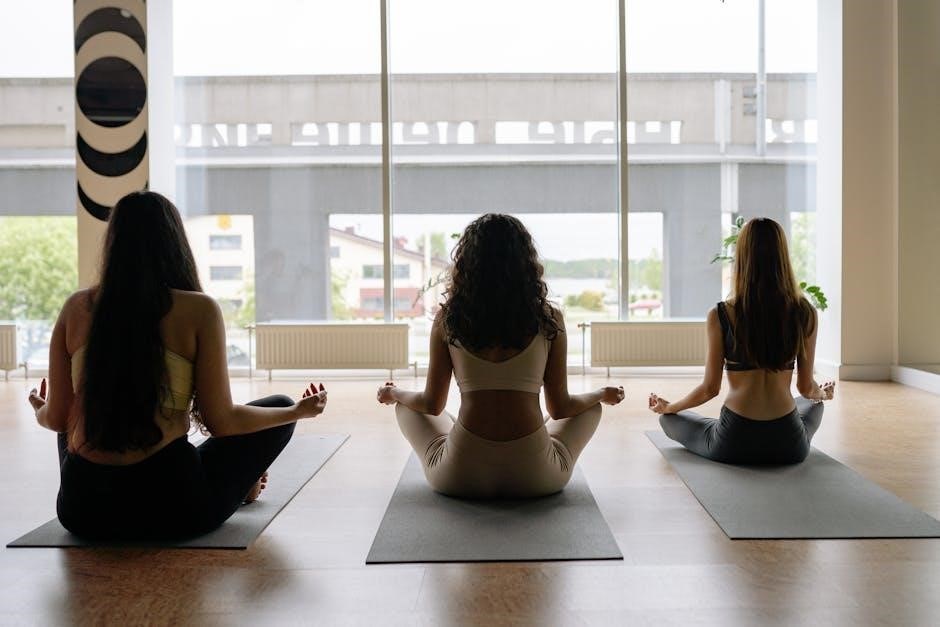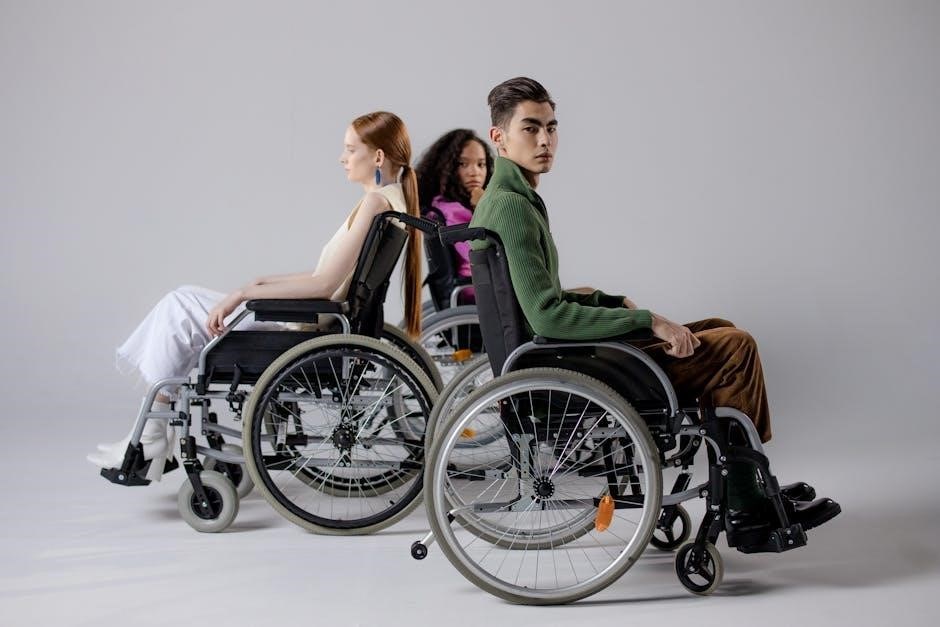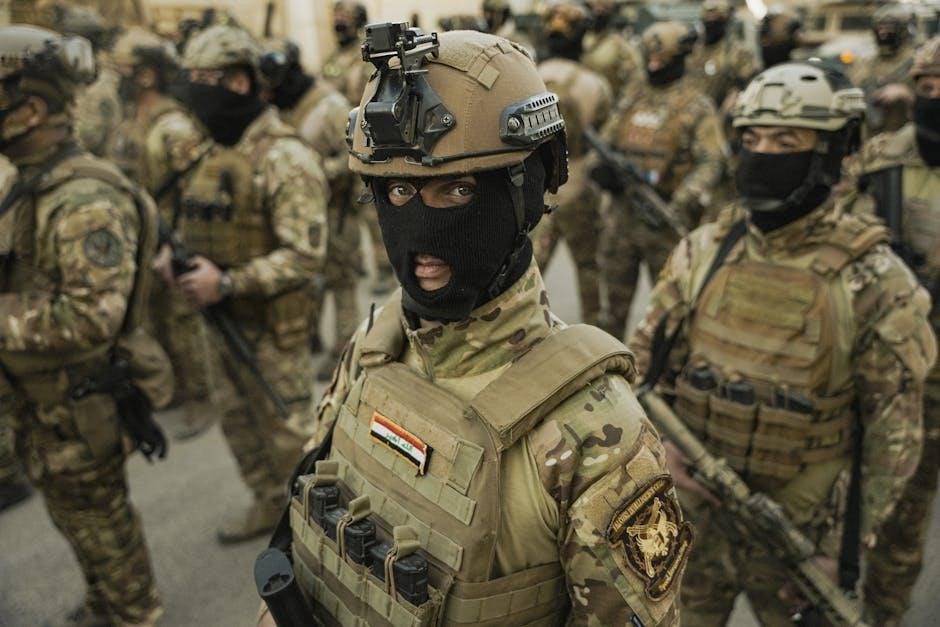STNR Reflex Integration Exercises are evidence-based techniques to help individuals, especially children, overcome retained primitive reflexes. Guides like Integrating Primitive Reflexes Through Play and Exercise by Kokeb Girma McDonald offer interactive, PDF-available resources. These exercises promote developmental milestones and motor skills through playful activities, making them accessible for children and adults alike; By addressing retained reflexes, these exercises support overall neurological development and coordination.
What is the STNR Reflex?
The Symmetrical Tonic Neck Reflex (STNR) is a primitive reflex that plays a crucial role in developmental milestones. It typically emerges around 6-9 months of age and integrates by 12-18 months. The STNR reflex involves the automatic movement of the arms and legs in response to neck flexion or extension. When retained, it can impact motor skills, posture, and coordination. Kokeb Girma McDonald’s guide highlights its significance in reflex integration, emphasizing how exercises can help overcome challenges associated with retained reflexes, such as poor handwriting or balance issues, by promoting proper neurological development and integration.
The Importance of Reflex Integration
Reflex integration is essential for proper neurological development, enabling the brain to mature and function efficiently. Primitive reflexes, like the STNR, play a vital role in early development but should integrate as the child grows. Retained reflexes can lead to challenges in motor skills, coordination, and cognitive development. Integrating these reflexes through targeted exercises helps improve posture, balance, and overall brain-body coordination. This process is crucial for overcoming developmental delays and enhancing learning capabilities, as highlighted in guides like Kokeb Girma McDonald’s, which provide practical strategies for effective reflex integration.
Benefits of STNR Reflex Integration Exercises
STNR Reflex Integration Exercises offer numerous benefits, including improved motor skills, enhanced coordination, and better posture. These exercises strengthen the brain-body connection, aiding in developmental progress. They are particularly beneficial for children with delays, promoting smoother transitions through developmental milestones. By integrating the STNR reflex, individuals can experience improved balance, finer motor control, and enhanced learning capabilities. Interactive and play-based approaches make these exercises engaging and effective, as detailed in resources like Kokeb Girma McDonald’s guide, which provides comprehensive strategies for successful integration.
Understanding Primitive Reflexes
Primitive reflexes are automatic, stereotypical movements crucial in early development. They lay the foundation for voluntary motor skills and coordination, maturing as the brain develops.
Definition and Role in Development
Primitive reflexes are automatic, stereotypical movements present from birth, essential for early survival and development. They serve as the foundation for voluntary motor skills, posture, and coordination. These reflexes typically integrate as the brain matures, allowing for more complex movements and cognitive functions. When retained beyond typical developmental stages, they can hinder coordination, posture, and learning. Understanding their role is crucial for addressing developmental delays and promoting integration through targeted exercises, as outlined in guides like Integrating Primitive Reflexes Through Play and Exercise.
Common Primitive Reflexes and Their Functions
Primitive reflexes include the Tonic Labyrinthine Reflex (TLR), Spinal Galant Reflex, Asymmetrical Tonic Neck Reflex (ATNR), and Symmetrical Tonic Neck Reflex (STNR). Each reflex plays a specific role in early development. The TLR aids posture and balance, while the Spinal Galant Reflex supports trunk movement. The ATNR facilitates hand-eye coordination, and the STNR supports crawling and head control. These reflexes lay the groundwork for voluntary movement and higher-level motor skills. Proper integration ensures smooth transitions to more complex physical and cognitive abilities.
How Primitive Reflexes Impact Motor Skills and Coordination
Primitive reflexes significantly influence motor skills and coordination. When these reflexes are retained, they can interfere with voluntary movements, causing challenges in balance, posture, and fine motor tasks. For example, retained STNR or ATNR reflexes may lead to difficulties with handwriting, coordination, or maintaining proper posture. These reflexes can also delay developmental milestones, such as crawling or walking. Effective integration of primitive reflexes through targeted exercises promotes smoother transitions between reflexive and voluntary movements, enhancing overall motor function and coordination. This is crucial for achieving age-appropriate physical and cognitive abilities.

The Science Behind Reflex Integration
Reflex integration involves reorganizing brain pathways to replace automatic responses with voluntary movements, enhancing coordination and posture through targeted exercises and neural plasticity.
Neurological Basis of Reflex Integration
Reflex integration is rooted in neuroplasticity, where the brain reorganizes pathways to replace primitive reflexes with voluntary movements. The process involves the brainstem, cerebellum, and cortex, enhancing motor control and posture. As reflexes mature, neural connections strengthen, improving coordination and balance. This neurological adaptation allows individuals to progress from automatic responses to intentional actions, fostering overall developmental growth and functional skills.
How Exercises Influence Brain-Body Connection
STNR reflex integration exercises enhance the brain-body connection by strengthening neural pathways between the central nervous system and muscles. Through repetitive movements, such as crawling or creeping, the brain learns to inhibit primitive reflexes, replacing them with voluntary control. This process improves coordination, posture, and overall motor skills. The exercises stimulate neuroplasticity, allowing the brain to adapt and refine its communication with the body. Consistent practice fosters greater synchronization, leading to more efficient and intentional physical responses.
Developmental Milestones and Reflex Maturation
Developmental milestones mark the progression of motor and sensory skills, with reflex maturation playing a crucial role. The STNR reflex typically emerges around 6-9 months and integrates by 12-18 months, allowing for more complex movements. Retained reflexes can hinder milestones, causing delays in posture, coordination, and fine motor skills. Proper maturation enables smooth transitions between developmental stages, fostering independence in activities like sitting, crawling, and walking. Understanding these milestones helps identify when reflexes may need integration support to ensure optimal developmental outcomes.

STNR Reflex Integration Exercises
STNR reflex integration exercises enhance posture, coordination, and motor skills through targeted movements. Tailored for all ages, these exercises improve brain-body connection, fostering developmental progress and balance abilities effectively.
STNR-specific exercises are designed to integrate and mature the Spinal Tonic Labyrinthine Reflex, enhancing posture, coordination, and overall motor skills. These exercises target the brain-body connection, fostering proper reflex development. By replicating natural movements, they help individuals, especially children, overcome retained reflexes. Regular practice improves balance, fine motor abilities, and focus. Tailored to various developmental stages, these exercises provide a foundation for advanced motor skills and long-term neurological benefits. They are often used in therapeutic settings and home programs to support growth and developmental milestones effectively.
Step-by-Step Guide to Performing STNR Exercises
Begin by sitting or standing with proper posture. Slowly tilt your head back, looking upward, and hold for 5-10 seconds. This activates the STNR reflex. Return to the starting position and repeat 5-10 times. Next, incorporate arm movements: as you tilt your head back, extend your arms forward and slightly upward. Hold, then slowly lower your arms as you return your head to neutral. Perform 3 sets daily. Ensure smooth, controlled movements and avoid rushing. Supervision by a professional is recommended for proper form and safety.
Progressive Exercises for Advanced Integration
For advanced STNR integration, incorporate dynamic movements. Start with single-leg stands while performing head tilts, holding 10-15 seconds per leg. Add arm extensions with resistance bands or light weights to enhance neurological engagement. Progress to eye-tracking exercises, such as following a moving object while maintaining posture. Integrate balance tools like wobble boards or BOSU balls to challenge stability. Gradually increase exercise duration and complexity. Always supervise children or individuals with special needs to ensure proper form and safety. These progressive exercises help refine motor skills and deepen reflex integration for long-term benefits.

Exercises for Reflex Integration Through Play
Playful activities like crawling, clapping, and jumping enhance reflex integration. These engaging exercises promote motor skills and coordination while making learning fun for children.
Play-Based Activities for Children
Play-based activities are essential for STNR reflex integration, making exercises fun and engaging. Games like “Simon Says” and “Red Light, Green Light” encourage balance and coordination. Obstacle courses with crawling, climbing, and jumping help integrate reflexes naturally. Activities like clapping games enhance rhythm and timing, while dance parties promote gross motor skills. These playful exercises not only aid in reflex integration but also foster creativity and social interaction, making learning enjoyable and effective for children.
Interactive Games to Enhance Reflex Integration
Interactive games are a powerful tool for STNR reflex integration, fostering engagement and skill development. Activities like “Follow the Leader” and “Animal Moves” encourage mimicking actions, improving coordination. Balloon volleyball and beanbag tosses enhance hand-eye coordination and timing. Games involving gentle bumps or light touches, such as “Red Rover,” help integrate sensory responses. These playful, interactive exercises create a dynamic environment for children to practice reflex integration while building social skills and confidence. They make learning fun and effective, promoting overall developmental progress.
Using Toys and Props to Facilitate Learning
Toys and props play a vital role in STNR reflex integration by making exercises engaging and accessible. Tools like balance beams, wobble cushions, and sensory balls encourage children to practice postural control and coordination. Using familiar toys in structured activities, such as tossing a ball while maintaining posture, helps integrate reflexes naturally. Props like weighted blankets or fidget toys can also provide sensory feedback, aiding in focus and motor skill development. Incorporating play-based tools ensures that learning is both effective and enjoyable for children, fostering long-term developmental progress.

Reflex Integration for Specific Populations
Reflex integration exercises can be tailored for children with developmental delays, adults with retained reflexes, and individuals with special needs, ensuring personalized and effective outcomes.
Exercises for Children with Developmental Delays
Children with developmental delays benefit from tailored STNR reflex integration exercises to enhance motor skills and coordination. Activities like crawling, creeping, and prone extension help stimulate reflex maturation. Repetitive movements, such as shoulder rolls and head lifts, strengthen neck and shoulder control. Sensory integration techniques, including tactile stimulation, can support exercise effectiveness. Visual aids and interactive games make exercises engaging. Professional guidance ensures exercises are adapted to individual needs, fostering progress and confidence. Regular practice helps improve posture, hand-eye coordination, and overall developmental milestones in a fun and supportive environment.
Adaptations for Adults with Retained Reflexes
Adults with retained STNR reflexes can benefit from modified exercises tailored to their needs. Focus on posture correction, stress reduction, and enhancing coordination. Modified movements, such as seated cervical retractions or wall slides, help integrate the reflex. Breathing exercises and mindfulness practices complement physical activities. A personalized approach, often involving occupational therapists, ensures exercises are adapted to address specific challenges. Regular practice can improve posture, reduce muscle tension, and enhance overall motor control, promoting better functional abilities and daily performance. Consistency and professional guidance are key to successful integration.
Specialized Techniques for Individuals with Special Needs
Individuals with special needs may require tailored approaches to STNR reflex integration. Sensory integration techniques, such as weighted blankets or joint compressions, can complement exercises. Visual supports, like schedules or exercise cards, help clarify expectations. Adaptive equipment, such as larger grips or supportive seating, ensures accessibility. Environmental modifications, including dim lighting or minimal distractions, create a calming space. Collaboration with occupational therapists is crucial to design personalized programs. These techniques enhance participation, engagement, and progress in STNR integration, fostering independence and confidence. Regular adaptation ensures exercises remain effective and enjoyable for diverse abilities and needs.

Assessment and Identification of Retained Reflexes
Accurate assessment involves clinical observations, movement analysis, and standardized tests to detect retained reflexes. Early identification ensures timely intervention, promoting optimal developmental outcomes and motor skill refinement.
Signs and Symptoms of Retained STNR Reflex
Retention of the STNR reflex may manifest as poor posture, difficulty with hand-eye coordination, and challenges in maintaining focus during tasks. Individuals might exhibit involuntary movements, such as arm or leg flailing, and struggle with fine motor skills like handwriting.
There may also be delays in achieving developmental milestones or difficulties transitioning between activities.
These symptoms highlight the need for early identification and targeted exercises to support integration and improve overall motor function and academic performance.
Tools and Methods for Assessing Reflex Integration
Assessing reflex integration involves standardized tools and observational methods to identify retained reflexes; Techniques include posture and movement analysis, joint mobility tests, and reflex-specific assessments like the STNR reflex test.
Practitioners may use clinical observation, parent or teacher questionnaires, and motor skill evaluations.
These tools help determine the presence and impact of retained reflexes, guiding the development of targeted exercises to support integration and improve motor function. Regular assessments track progress and refine intervention strategies.
Creating a Personalized Exercise Plan
A personalized exercise plan is tailored to address specific reflex integration needs based on assessment results. It begins with clear goals, such as improving posture or enhancing coordination.
Exercises are selected to target retained reflexes, with detailed instructions on execution, frequency, and duration.
Progress monitoring and adjustments are included to ensure effectiveness.
The plan may incorporate play-based activities for children or adaptive strategies for adults, ensuring engagement and consistency. Regular reviews allow for modifications to support ongoing development and integration of reflexes.

Combining STNR with Other Reflex Integration Techniques
Combining STNR with other reflex integration techniques enhances motor skills and coordination. Integrating ATNR and TLR reflexes supports balanced development, improving posture and overall brain-body connection effectively.
Integration with ATNR Reflex Exercises
Integrating STNR with ATNR reflex exercises enhances developmental outcomes. The ATNR (Asymmetrical Tonic Neck Reflex) influences head and limb coordination, while STNR focuses on posture and eye-hand coordination. Combining these exercises promotes balanced reflex maturation, improving overall motor skills. Specific movements, such as head rotations and cross-lateral exercises, can be incorporated to target both reflexes. This dual approach strengthens neural connections, aiding in more efficient integration. Professionals often recommend this combination to address retained reflexes in children and adults, ensuring comprehensive developmental progress. Proper guidance is essential to avoid overstimulation and ensure effective integration.
Combining STNR with TLR Reflex Integration
Combining STNR with TLR (Tonic Labyrinthine Reflex) integration enhances postural stability and balance. The TLR reflex influences the body’s response to movement and gravity, while STNR focuses on head-neck coordination. Exercises that incorporate both reflexes, such as heel-to-toe walking and cross-lateral movements, can improve overall motor skills. This combination helps individuals achieve better balance, coordination, and posture; Practitioners often recommend sequential integration, starting with TLR to establish foundational stability before advancing to STNR exercises. This approach ensures a holistic development of reflexes, reducing retained reflex interference and promoting long-term functional improvements.
Sequential Approach to Multiple Reflex Integration
A sequential approach to reflex integration ensures that reflexes are addressed in a logical order, building from foundational to complex movements. This method often starts with primitive reflexes like ATNR and TLR, which lay the groundwork for postural stability and balance. Gradually introducing STNR exercises helps refine head-neck coordination and upper body control. By systematically integrating reflexes, individuals can achieve better posture, coordination, and overall motor function. This structured progression minimizes overwhelm and enhances the effectiveness of each exercise, leading to more sustainable developmental improvements over time.

Resources for STNR Reflex Integration
Explore detailed PDF guides, expert webinars, and interactive tools for STNR exercises. These resources provide structured plans, visual aids, and expert insights to support effective integration practices.
Recommended Books and Guides
Enhance your understanding with books like “STNR Reflex Integration: A Comprehensive Guide” and “Primitive Reflexes and Brain Development.” These resources offer in-depth strategies, case studies, and step-by-step exercises. Digital guides, such as “STNR Exercises for Home Use,” provide accessible PDF formats for easy reference. Additionally, “Reflex Integration Through Play” combines theory with practical activities. These materials cater to parents, therapists, and educators, ensuring a holistic approach to integrating the STNR reflex effectively. They are essential tools for creating personalized exercise plans and tracking progress.
Online Courses and Tutorials
Expand your expertise with online courses like “STNR Reflex Integration: From Theory to Practice” on Udemy and Coursera. These courses provide detailed video tutorials, downloadable PDF guides, and interactive exercises. Platforms like Sensory Integration Academy and Reflex Integration Hub offer specialized training for therapists and educators. Topics include identifying retained reflexes, creating personalized plans, and advanced techniques for integration. Many courses include downloadable PDF workbooks and progress tracking tools, making learning accessible and structured for both professionals and parents seeking to support STNR integration effectively.
Downloadable PDF Worksheets and Charts
Enhance your practice with downloadable PDF resources like “STNR Reflex Integration Exercises” and “Reflex Integration Tracking Charts;” These worksheets offer step-by-step exercises, progress monitoring templates, and visual guides for proper posture and movement. Websites like TherapyWorks and ReflexIntegrationPro provide printable PDFs designed for therapists, educators, and parents. Charts include visual aids for understanding reflex stages and integration milestones, while exercise logs help track progress. These tools are ideal for creating structured, personalized plans and ensuring consistent practice for effective STNR integration.

Case Studies and Success Stories
Discover real-life examples of individuals who achieved remarkable progress through STNR reflex integration exercises. Detailed PDF case studies reveal improved motor skills, focus, and overall development in children and adults. Evidence-based success stories highlight measurable outcomes, offering inspiration and proof of the effectiveness of these exercises in overcoming developmental challenges and enhancing neurological function. These testimonials provide hope and practical insights for those seeking to integrate STNR exercises into their therapeutic or educational plans.
Real-Life Examples of Successful Integration
Discover inspiring stories of individuals who successfully integrated the STNR reflex through targeted exercises. Case studies detail children with developmental delays improving posture, handwriting, and focus after consistent practice. Adults with retained reflexes also report enhanced coordination and reduced stress. These examples, often documented in PDF guides, showcase how tailored exercises can lead to transformative outcomes, improving daily functioning and overall quality of life. Such success stories highlight the practical benefits of STNR integration and motivate others to explore these techniques for themselves or their loved ones.
Overcoming Challenges in Reflex Integration
Integrating the STNR reflex can present challenges, such as inconsistent practice or lack of guidance. Many individuals struggle with maintaining motivation or understanding proper techniques. To overcome these, creating a structured routine and seeking support from professionals or PDF guides is essential. Gradual progression and celebrating small successes can also enhance adherence. Additionally, addressing emotional or sensory sensitivities through adapted exercises ensures a smoother integration process. Persistence and personalized strategies are key to overcoming obstacles and achieving long-term success in STNR reflex integration.
Testimonials from Practitioners and Parents
Practitioners praise the clarity and effectiveness of STNR reflex integration exercises, noting significant improvements in patients’ coordination and focus. Parents report that incorporating these exercises into daily routines has enhanced their children’s academic performance and emotional regulation. Many highlight the accessibility of PDF guides, which provide step-by-step instructions and visual aids. Overall, testimonials reflect widespread satisfaction and measurable benefits, emphasizing the positive impact of STNR integration on both developmental and daily functioning.

Future Directions in Reflex Integration
Emerging research focuses on advancing STNR integration techniques, leveraging neuroscience breakthroughs. Technological tools, like apps, are being developed to enhance exercise precision and accessibility for diverse populations.
Emerging Research and Techniques
Recent studies explore innovative approaches to STNR reflex integration, incorporating neuroimaging and AI to track progress. Researchers are developing personalized exercise protocols based on real-time brain activity feedback. Advances in virtual reality (VR) create immersive environments for enhanced sensory integration. Collaborative efforts between occupational therapists and neuroscientists aim to refine techniques, improving outcomes for individuals with retained reflexes. These cutting-edge methods focus on optimizing exercise effectiveness, ensuring better adaptability for diverse populations, and simplifying home-based programs. The integration of technology promises to revolutionize how STNR exercises are designed, implemented, and monitored for long-term success.
The Role of Technology in Reflex Integration
Technology is transforming reflex integration by providing innovative tools for STNR exercises. Mobile apps now offer guided programs, timers, and progress tracking, making home-based practice more accessible. Sensors and wearable devices provide real-time feedback on movement accuracy, enhancing exercise effectiveness. Virtual reality (VR) and augmented reality (AR) create engaging, interactive environments for children to perform exercises; Additionally, teletherapy platforms enable remote consultations and personalized coaching. These technological advancements not only improve adherence but also make reflex integration more engaging and efficient for individuals of all ages and abilities.
Expanding Awareness and Education
Expanding awareness and education about STNR reflex integration is crucial for its widespread adoption. By sharing knowledge through workshops, webinars, and downloadable resources like PDF guides, more parents, educators, and therapists can understand its benefits. Social media and online platforms are key tools for disseminating information, while partnerships with schools and healthcare providers can further promote its importance. Educating the public empowers individuals to take proactive steps in improving developmental outcomes, making reflex integration a mainstream practice for enhancing motor skills and cognitive function in both children and adults.
Summarizing the Benefits of STNR Integration
STNR reflex integration enhances posture, balance, and motor skills, fostering better coordination and focus. It improves academic performance and reduces developmental delays. Simple exercises yield long-term benefits, boosting confidence and overall physical abilities. Regular practice supports brain-body connection, aiding individuals of all ages. This approach is particularly valuable for children with special needs, promoting independence and skill mastery. By addressing retained reflexes, STNR integration creates a strong foundation for lifelong learning and physical excellence.
Encouraging Continued Practice and Learning
Consistency is key to maximizing the benefits of STNR reflex integration. Encourage individuals to incorporate exercises into daily routines, even for short durations. Celebrate progress, no matter how small, to build motivation. Provide access to resources like PDF guides for easy reference. Educators and caregivers should model practices and offer positive reinforcement. Engaging activities and varied exercises can prevent boredom and maintain interest. Regular check-ins and goal setting help sustain commitment. Emphasize the long-term benefits of improved motor skills and cognitive function to inspire dedication.
Final Thoughts on the Importance of Reflex Integration
Reflex integration, particularly focusing on the STNR reflex, plays a pivotal role in enhancing motor skills, posture, and cognitive development. By addressing retained reflexes, individuals can achieve better coordination, focus, and overall neurological balance. Consistent practice and tailored exercises, as outlined in PDF guides, empower long-term improvements. Parents, educators, and practitioners must advocate for these practices, ensuring individuals reach their full potential. The journey of reflex integration is a lifelong investment in health and well-being, fostering resilience and adaptability in an ever-changing world.
